Review: #10332 Medieval Town Square (LEGO Icons)
Medieval village sets are crowd-pleasers that have appeared periodically throughout the LEGO Castle theme’s long history, but is this modern interpretation good enough to meet modern expectations?
The highly anticipated 10332 Medieval Town Square will be released on March 1, 2024. Coming with a whopping 3304 pieces, 8 minifigures and a brand new Goat; this remake of 2009’s Medieval Market Village can’t escape comparisons with it’s wildly popular predecessor. Let’s explore how this set compares, and whether it is deserving of all the hype or falls short.
The medieval era draws the fascinations of many, with LEGO capitalizing on this over the last few years with some high quality LEGO sets. This set is no different as LEGO goes all out, entrusting the design of 10332 Medieval Town Square to veteran LEGO designer Henrik Rubin, a designer who has designed over 100 sets since 1995. Henrik’s portfolio includes many iconic favorites including the early line of Adventurers sets with Johnny Thunder, the early Harry Potter sets released from 2001, sets in both Castle and Kingdom themes, the Lord of the Rings sets amongst many more.
The set has been designed to the same doll-house style play we have seen in other castles giving the builder the flexibility to pose the structures how they see fit. This technique allows the designers to utilize empty space to make the structures larger and not use up many pieces to close off the backside of the buildings as through use of hinges two buildings can be combined together should closure be desired. This modular design style takes influences from the LEGO modular sets that we all love and has been designed with group play in mind as each building can be built using its own instruction manual.
The set itself comes with a whopping 3304 pieces and is priced at $229.99(£199.99/€229.99) giving it a very favoritable price per piece of 7.0c(6.1p/7.0c). While this number seems alluring it is important to remind that price per piece alone is not an indicator of value, something we will go into more detail on in the value section. It comes with 8 minifigures and sees the second 2024 variant of the highly sought goat, now in 199Dark Stone GreyDark Bluish Gray.
- LEGO Parts Weight: 2249 grams
- Price per piece: $229.99 / 3304 pieces = $0.0696 per piece
- Price per gram: $229.99 / 2249 = $0.102 per gram
Packaging and instructions
Continuing their target to Adult Fans Of Lego (AFOL) this set adopts the iconic black styled box donning the immediately recognizable Icons logo (formerly known as Creator Expert prior to the summer 2022 rebrand). Both the front and the back of the box showcase the contents of this set very well, showcasing the different ways the structures can be displayed and some of the notable play sets. While the box can show off a lot of the contents inside the set this alone is not enough to show off all the included details and build techniques. This review aims to highlight these details better to ensure you can make a more informed decision before you purchase.

The back of the box is packed with details highlighting the contents of the set. (Photo: The LEGO Group).
As this set is split across two buildings it makes sense to split up the instructions accordingly. Each instruction manual builds one of the two structures allowing you to build in parallel should you chose so. The instructions are packed to the brim with details and includes comments throughout the build to share insights into what you are building. While this set is sized such that one instruction manual could be sufficient this design choice was a fun inclusion. Don’t forget to scan the QR code on the front of your manual should you pick up this set to get yourself some free Insiders points!

Two instruction manuals allow you to build the two structures in parallel if you enjoy group building.
To help create a more lasting impression the designers went all out with world building for this set and have created a back story for the village and all of the characters. In an interview with Henrik he said that when he builds characters he asks questions such as “What kind of life do they have? What is their name? What job do they do? How do they link together with other characters? And so on”, which aided him in design elements for the set. Stories always allow you to be more creative. This backstory is beautifully highlighted and illustrated in the first few pages of the instructions allowing the builder to immerse themselves in the world. To not spoil this backstory we will not be digging into its details in this article as we want to allow you to come up with your own story to supplement. One fun, and unsure if intentional easter egg may come with the naming of this village. The village is named Felsa, which when I did a quick online search brought up that Felsa Yehr is an aged Manchego sheep’s cheese from a Pennsylvania based local cheese business named Goot Essa. With cheese being prominent in this set due to the inclusion of the cheese story and cheese factory, and with the return of the Goat which matches the name of the business closely I am unsure whether this is intentional or just coincidental naming.
Build Process
While the set is split into two instruction manuals and two main structures the designers creatively built the set in a way such that it features five different buildings. Each of the buildings included in this set have their own unique function and include structures that we have not previously seen in LEGO structures. The buildings included are an old farmhouse, a cheese factory, an inn, a barn, a shieldsmith workshop and a watchtower. The buildings are designed to be modular allowing you to display them however you see fit, following the same techniques used in other recent castle sets that give you display fluidity. The set itself is packed with secrets and hidden references, some of which we will highlight in this set while others we will leave for you to find to ensure there is still magic in your build experience. In this review we will be covering details of the structures, some of the great colors used and go into details of the build techniques we see deployed in this set.
Building 1 – Old Farmhouse, Cheese Factory, Barn
When opened up you can see the power of empty space. While each of the three structures themselves are relatively small, the use of hinged pieces lets you open it up to create the narrow passage way between these buildings. While they are connected at hinges, the designers did a good job at hiding these, ensuring they blend and do not mar the facade of the buildings. As we dig into each of the building seperately we can see what makes them special, while exploring the similarities and differences between how they are each built.
In contrast, when the buildings are placed side by side and opened up we see the true size of these buildings, with them feeling a lot smaller. Despite this the buildings still look beautiful when displayed this way, with the dollhouse opening being hidden in the inside walls. Each building is distinct in its color, shape and design allowing for a nice varied contrast, while all feeling unique. While there is more to this set I feel that this building on its own would make for a great LEGO set, and were it released at a lower price point would make for an affordable entry point into castle for LEGO fans, as the theme is currently filled with very expensive sets. While the colors themselves are varied you can see a lot of repetition in building techniques across the buildings, something we see even more as we build the second structure. We will explore this repetition further in the article and how this unfortunately may detract from the building experience. I will caveat however that I have been fortunate to build a lot of the newer castle sets, so while some of these techniques may seem repetitive to me, I may be skewed from biases having built this technique a lot. It is important to note that repetition does not mean the technique is bad however, as everything from the walls to the roof are gorgeous in this set.
Although not likely posed this way, you can see the interior details of each building when you open up the structure and look at it from the back. You can see that the designers put a lot of detail into all sides of each structure. This way every angle can be displayed nicely. As you look at the interior details of each side by side you can see the varied structural building techniques used for the sets and see the beautiful interior timbered frames. It is a shame I won’t see much of this view due to how I display the sets.
Mini builds
To supplement the buildings and to add play and details the designers have included a large number of mini builds in this set. These mini builds can be placed in the larger structure but are designed to be removed such that they can be posed as desired. Each of the mini builds add small details that enhance the set and each feel like they could be part of a LEGO Castle advent calendar. The first thing we build is a 21Bright RedRed and 1White crowned cheese stall. While a small build this stall makes great use of a variety of shapes and colors, including 24Bright YellowYellow, 191Flame Yellowish OrangeBright Light Orange, 1White and 312Medium NougatMedium Dark Flesh to capture different cheeses. It is incredible how just through use of 1×1 pieces you can create so much recognizable variety. Alongside the cheeses are a variety of baked goods, items that are commonly eaten with cheese. While the build itself is simple it is interesting to point out some creative techniques, firstly with the roof detailing. In the past we have seen the curved patterns accomplished through use of slopes and arches, but instead this time we get a more rounded shape accomplished through the use of brackets and rounded off 1×1 studs, a simple change that adds a fun new shape. Although not easily noticable the designers were able to connect the thin bar of the frames to the flat roof through the use of a 1×1 rounded tile with a hole in it. This very versatile piece allows for bars to connect to anti studs, a connection that previously would not have been possible allowing for much thinner detailing. This looks a lot nicer than it would have had they used 1×1 rounded bricks.
As part of the workshop we build a chair and a table that the carpenter has built. Even including a small stickered schematic. Those with keen eyes will notice that the chair uses the same technique that is used for the dining table chairs in the Lion Knight’s Castle set which adds to world building. The only difference here being that this chair uses the lighter 5Brick YellowTan color to represent unstained and unfinished wood.
Utilizing a large number of small pieces is the cart. Unlike other carts we have seen in other castle sets this one is sized to be hand drawn. While an intentional design decision I wish it was instead sized larger and drawn by a horse or cow as this set is missing the larger animals we saw in the original this is based off. The build itself is rather straight forward but it is interesting to notice that clip and bar connections are used in full effect to accomplish the angled walls of the cart. By placing it at an angle we get more shape variety than had we seen them built up with bricks at a right angle.
Probably the most beautiful sticker in this set is used for the tapestry. Depicted on this tapestry are two iconic LEGO sets. Firstly 1978’s 375 Castle (also known as Yellow Castle) and 1979’s 383 Knight’s Joust. These iconic classic sets are paid homage to and are faithful to the originals where LEGO Castle began. For a sticker this nice I wish it was included as a print as this would add so much more allure to this set. While a print would have been nice, this would have meant you have no flexibility over how this sticker can be applied. While I applied it in the recommended orientation you can also rotate the sticker 180 degrees so that this tapestry can be clipped in a custom MOC as a hanging tapestry. Stickers like this make me wish you were able to purchase stickers directly from LEGO as this would be one I want to buy more of. While the tapestry gets all the attention it is important to also give the loom itself some love. This beautifully built loom is faithful to the original piece of instrument, utilizing a large number of small pieces and lots of clip and bar building techniques. Although intricate, the build itself can be rather flimy until it is all put together so needs to be built carefully.

While adding this sticker I was tempted to stick it upside down so it can be used as a hanging tapestry in MOCs.
Used together with the carving knife on the tool rack to shape logs from the log rack is a lathe. This simple build spins as you turn the dial at the back. Given the interpretation of LEGO’s builds this could also look like a loom, however is more likely a lathe. As we see both a loom and what could potentially be a spinning wheel it is a shame that this set did not include a sheep that one could shear to help provide the wool for these mini builds, a gap in the world building that the designers aimed for. We also build a small tool rack, while not an impressive stand alone build this helps fill the space in the barn with detailing. While the use of the gaps in the fence piece make for a great stand, the tools you insert feel a little unjointed as they sit loosely and rattle around should the set be moved. Not a negative but not a positive either.
Old Farmhouse
The old farmhouse is the smallest of the three buildings in the first set but from an exterior does not disappoint. Both the roof and door are a standout and will be explored in their own paragraphs later. The walls of this building leverage the half timbered building technique that is commonly found in German architecture spanning back as early as the 12th century, this named Fachwerk in native tongue. The 1White and 26Black of the walls contrast well, and even though the walls lack texture there is an illusion of it. To accomplish the thin 26Black strips the designers used studs on side construction and build horizontally utilizing 3 plate wide deep bricks for the main structure and a single plate for the thin detail. This technique is repeated across the entire structure and is something that we have seen before in LEGO castle buildings and will continue to see in the future. Where depth is achieved however is with the window shutters, with the designers using an ingot piece with its beveled shape to add some depth and curves to an otherwise flat wall.
A roof technique has seen in many castle sets is a thatched roof built using layered claws in 308Dark Brown. This technique it never fails to disappoint, with the shapes capturing the rough straw effect perfectly. To ensure the repetition is broken up we see a few slopes in 5Brick YellowTan interspersed amongst the larger claw pieces. What is new is how the designers curved the claws around a rounded window in this set. While it is far from perfect giving that there are gaps on either side of the window, the curve feels very naturally done and adds yet more character to the roof. To accomplish this curve clip and rod techniques are used to pose the claws at an angle, with the construction detailing being hidden by the layer of roofing above.
The outside is not alone with details, with designers using two large arches offset in height to build the roof trusses. This simple detail was easy to omit but shows the attention to detail. The interior however is rather sparse, with the main draw being the colored yarn on the wall that compliments the loom. It is important to note that the space is intentionally left to have enough room to store the loom should you wish to bring it indoors. What may seem like a simple detail is seen on the floor. The staggered 192Reddish Brown jumper streak that runs contrast against the 38Dark Orange tiles adds for a fun floorboard pattern, while also providing space for minifigures to stand within the building.
With many doors in sets utilizing a single piece door I always appreciate it when I see a brick build door. Although the build is far from the best brick built doors I have seen the 141Earth GreenDark Green tiles, both with its sharp and curved edges helps create the old rickety door feel. Brick built will always be something I appreciate as it helps highlight the creativity of LEGO, and although it drives up piece count and as a consequence price, it is nice to see from time to time. At the front we see a fun layered cobblestone technique using rounded tiles at the base of the door, a costly technique due to its use of a large number of pieces but a fun technique.
Cheese Factory
Of the three buildings in the first section the Cheese Factory feels the strongest, while unfortunately still having something to be desired. The first thing you notice is the roof, while the shape is beautiful the thatching is disappointing, especially when compared to the roof of the Old Farmhouse. Where the previous building excelled in its layered roof technique, this one falls short, instead opting for a more studs based finish with 138Sand YellowDark Tan plates and a handful of grille pieces in 312Medium NougatMedium Dark Flesh and claws in 138Sand YellowDark Tan for depth. The detailing for this roof almost feels like an afterthought. While it is important to keep variety to entertain the builder it felt a little lazier. When you compare this to details of angled rooves in Viking Village you can see that there is more to be desired. The farm space itself is very simple but fun. The fencing is simple yet rustic, with some rocks and foliage strewn across for nature details. For the large amount of farm space included there are not many animals, something I think this set is missing. Given that this is a Cheese Factory I feel this space needs a cow.
Where I gave benefit of the doubt to the roof for avoiding repetition I need to call out the repetitive design of the walls for this building. I firstly want to point out that I love the half timbered building technique as it captures colors perfectly. This time we see 5Brick YellowTan and 308Dark Brown as the two colors being used. While the colors may be different from the Old Farmhouse the techniques are not. We build the walls using the same varying depths and studs on side construction which made it a little repetitive. At least once we get to the higher levels we saw this change a little as this technique was no longer possible given the sloped frames. While the colors and varying thicknesses of this technique are beautiful they unfortunately lack depth. The walls themselves are very flat and lack texture and depth that gives it the popping effect. The designers could have changed it up a bit for this build and accomplished a similar feel but through the illusion of protruded beams. This could have been accomplished using tiles connected to studs on side construction wherever we saw 308Dark Brown to give an added one tile depth. We have seen this technique used before to great effect in sets such as Medieval Blacksmith. While not a huge detractor from a standalone structure point of view it is worth calling out as is factored into for build experience. While I will discuss it in more detail with the roof construction, we can see that the roof itself is a little finnicky, with the plates not connecting to the central bricks well and with this support nost resting on the frame properly. This unfortunately makes the roof a little delicate.
Although the exterior has some repetition the interior does not, with every wall packed with details. The floor tiles are meticulously arranged to give a angled checkered pattern, with enough exposed studs to allow minifigures to stand at different key spaces in the room. Although it may feel like parts padding, I like how the designers opted to use two triangular plates rather than a single 2×2 plate as the small gap running between the pieces adds yet another bit of texture. As this is a Cheese Factory it should come to no surprise that there are a large number of different cheeses all over the tables, curdling from milk to cheese. Once again we see a variety of 1×1 pieces in different shapes and colors representing the different cheeses. A brick built stove, fit with a flame sits in the corner. The chimney of this stove runs all the way to the ceiling and continues through the roof. While a small detail it is worth highlighting that the chair included in this room is different to that we saw being built by the carpenter, with this one being less ornate. While not missed if not included the addition of a kitten is a nice touch. Given that this is a Cheese Factory, the presence of a cat is crucial to keep rodents at bay, being a common household companion in the Medieval era where rodents and plagues ran rampant.
To allow for the roof to be removed there is no structural connection holding the roof in place, instead having the roof sit on the slopes of the frame. While this allows for easy addition and removal it meant that the roof never sat snugly, having a slight lean on either side. Although there is a resting point at the top of the frame, the roof itself does not sit into this very well, and should you force the roof into this it breaks apart rather easily. Although the roof itself is flat on either side, interestingly the frame itself does not follow the roof’s flat shape, with the designers using slopes of different angles running down the side. Included in this building is a brand new door mold. Previously we have seen wooden doors with grain in a rounded shape, with this time the door being a regular rectangular door. I am sure this door will be a popular addition to peoples’ custom builds, with it adding a new door texture to the common doors we see in this size.
To create the vaulted roof in this set the designers had to be creative from a structural point of view. To accomplish the angled shape built by two plates the designers build a structural element using bricks with studs on side for support. Despite the rigidity of this construction there is still a lot of fragility in this structure, with the majority of connection resting across the ridge of the roof. This unfortunately meant that when installing the roof onto the support, should you push to hard it will fall apart rather easily. I think the use of bracket pieces would have been more effective here.
Barn
The central building of this set of buildings is very different from the other two. Not just appearance but in utility. While this building does not have an official name, based on appearance and utility I can only assume it to be a barn, having ample space for the villagers to store their tools, materials and builds. Unlike the other two buildings which were built to resemble wood, this instead uses stone. Utilizing the sharp 194Medium Stone GreyLight Bluish Gray brick color to achieve this effect. Unlike the two buildings we previously explored this one shakes it up a bit, utilizing a variety of different bricks to accomplish the shapes and textures. Both flat and masonary bricks are used for the main surface texturing, with the occasional rounded brick interspersed. Rather than being hidden the designers utilize arches as part of the main external detailing, giving the space a very airy open feel, allowing light to enter the space for ease of internal viewing. Resting at the top of the structure is a pulley and winch mechanism that is controlled by a gear on the side of the structure. This mechanism, albeit simple, allows for a small play feature as you raise items into the loft. The exposed exterior mechanisms are hidden when the three buildings are put side by side, however this slight exposure when opened does not detract. We see the same roof technique that was used in the Cheese Factory in 5Brick YellowTan. While the exterior has a myriad of details I want to point the attention to the shutters. The exposed 141Earth GreenDark Green contrasting against the 194Medium Stone GreyLight Bluish Gray not only allow for the interesting color differential, but through use of the 1 plate deep exposure we get added depth. This very simple addition helps create a more 3 dimensional feel to the structure and is something we should have seen with the other two buildings.
As the building spans over two levels the designers took influence from the modular line of sets to allow each level to be removed to see the details within. Similar to what we have seen with the roof of all of the three buildings. To accomplish this ease of removal the top of the first level is lined mostly with tiles with a few exposed studs to serve as connection points. This lets the two levels connect, while also being easy enough to seperate. I love this simple technique whenever it is used in LEGO as it allows for a great cross sectional view from above to see details within.
Despite being very small the designers put a lot of thought into the hanging torches. Each built using only 6 pieces we see a variety oof ridges, heights and depths accomplished to create a beautifully built torch. While the designers could have just opted to use the single hanging lantern or torch piece, this demonstration shows the power of small pieces to build up details. Whether this justifies the cost increase by brick built structures is in the eye of the beholder. Another utilization of small pieces is seen with the cobblestone walkway leading up the the front door. Through various shaped 1×1 tiles in 199Dark Stone GreyDark Bluish Gray and 194Medium Stone GreyLight Bluish Gray the designers create a very stony pattern that closely resembles that of cobblestone.
Resting out back and angled over the back entrance is a bright awning donning 23Bright BlueBlue, 1White and 140Earth BlueDark Blue colors. This small addition adds yet more color to the 194Medium Stone GreyLight Bluish Gray stony structure and feels very inviting. The alternating 23Bright BlueBlue and 1White colors have no exposed studs giving it a smooth texture, with curved slopes notched left and right giving a triangular finish. Although the colors and shapes are regal, the designers utilized 140Earth BlueDark Blue to serve as patchwork material to fix any tears in this faux fabric build, giving the awning a weathered look. While the awning is connected using clips to the stone structure behind it the designers utilized the same technique we saw with the cheese stall to create wooden support beams made out of bar pieces that connect to the anti studs of the bricks above. Rather than connecting this fully, as it is at an angle we instead have the anti stud resting on the bar. A small but detailed addition that helps the space feel more complete.
Central tree
As a supplementary build sitting besides the two large structures we build a grand tree. This tree utilizes a variety of new shapes we have not seen with trees before, even including a new recolored piece. While small details like water or mushrooms are included the stand out element of this build is the tree itself. The grand winding trunk tapers as it gets higher and is crownwed with a full head of leaves. Even amongst the lower branches we see this fullness captured, giving lots of volume to an otherwise small structure. Stickered signs are pinned to the trunk of the tree, each referencing a character or object in the world. My favorite easter egg included here is the sale sign for a goat. This sticker likely is poking fun at the collectors of the original goat who saw this as an investment but are now seeing the price drop with the new goats released in 2024.
The stickers and prints we have seen in past castle sets have foreboded new figures or sets we have seen in the future. Included in the signage are two references to other factions. The first being a wanted sign for the Wolfpack soldier included in this set and the second being a warning sign depicting Basil the Bat Lord from the 1997 Fright Knights. Given that the Series 25 Collectible Minifigures saw this minifigure return this sign is likely a reference to that figure but one could hope for a future small set for purchase, or even a gift with purchase set including the iconic dragon. As with many other stickers included in this set I wish these were instead printed as there are some great printed plates we have seen in the past. I am sure where LEGO falters with these, we will see third party prints of these stickers be released in the future.
First released in Ninjago as a dragon’s tail but now recolored in 192Reddish Brown is a wonderful new addition to a designers’ foliage arsenal. The ridges and angles of this piece make for amazing curved branches, and although you cannot include too many leaves to the end unless you modify it with additional pieces it adds a great shape. I can see this piece being one we see used in a lot of future trees.
Given that this is a tree the designers included a log rack and woodcutter’s axe. While there are no stumps that show a recently felled tree this could be foreboding the future felling of this beautiful tree. The build itself is nothing to write home to, using very few simple pieces but is a fun mini side build.
Building 2 – Broken Axes Inn, Shieldsmith Workshop and Watchtower
While the second set of buildings is made up of two different buildings there are three very clear styles evident in the structures. These being covered by the three spaces within, the Broken Axes Inn, a Shieldsmith Workshop and a Watchtower. It is evident that the design team researched actual medieval villages for inspiration, taking influences from what these structures would look like in real life. While there are some themes that are common across the different castle village buildings that has been built over the years, the dfesigners ensured that each have their own flavor while also incorporating some buildings that have not been featured in LEGO sets before, such as the workshop. Each of the buildings has a very distinct architectural style, but to ensure there is a common theme throughout we see some motifs repeated across the buildings, allowing for a homogeneous style to run throughout. Through use of hinges there is a lot of variety in the way these buildings can be displayed, but with the detailing available and based on the box art, the main focus leverages an angled display, allowing for all the details externally to be visibile.
The exterior may have beautiful colors and patterns but the interior is where all the life is. Each of the five rooms we build in this set are unique and represent a different space, each having its own brick built detailing to add character to the space. While the space can close the rooms are not designed to be connected to its counterpart in the other building so some of the decorations look disjointed if placed next to one another across the rooms. Everything from shape to color is varied across the rooms, giving it a lively feel to it.
While the height of the two structures is designed such that when closed they nestle into one another that doesn’t mean that this is most the most aesthetic way to display them. The contrasting colors and different heights of the interior levels makes the connection feel a little disjointed. Despite this the designers did their best, focusing attention on connective elements such as the wall and roof depths to ensure they don’t feel completely out of place.
Where I feel that closed up the shapes and colors do not flow into one another, when completely opened up this is opposite. Although the colors are contrasting, the different depth and height of the buildings makes it clear that these are two separate buildings, giving it a two houses on a village street feel. Sitting next to each other the contrasts of the colors are exemplified better, while highlighting the consistent theme across the two through its architectural techniques such as wall texturing and the roof. It is great that the designers build the two buildings on a hinge giving the builder flexibility to pose the buildings however they see fit. We will go into each of the details that makes the buildings what they are in their own respective sections below.
Mini builds
The second structure has a lot fewer removable mini builds, with most of the detail being built directly into the structure. Despite this the one included does not disappoint, including a beautiful printed heraldic shield. The beautiful sigil of the Lion Knights is painted onto this new printed shield and is likely the most beautifully printed piece in this set. The stand to hold the shield by contrast is rather basic, serving moreso as a support for th shield. The simple construction unfortunately can be difficult to pose, requiring you to pose each legs of the tripod carefully to ensure the structure does not tip over. I feel a simple plate based stand would work just as well here.
Broken Axes Inn
Of the wooden structures in this set the Broken Axes Inn highlights detailing best. It shows how having a common motif in building techniques, in this case the half timbered technique, can be used in conjunction with other detailing to not only add variety to what would otherwise be repetition but also enhance the shortcomings. The 330Olive Green color which serves as the main color blends seamlessly with the 138Sand YellowDark Tan to allow for a subtle difference. Where we previously saw flatness, it is now replaced texture and depth. An example of this is achieved with each level going up being one brick forward allowing for the use of slopes to transition. Additionally we see masonary bricks inlaid besides flat bricks for similar texture effects we saw in the stone barn. We see the depth accomplished through shutters taken advantage of again, this time having stickers add details, with the latch printed on to add detail. Given the 2×3 size of this shutter I understand why a sticker was used, but we could have seen a brick built technique similar to that we saw in Viking Village through use of the wand piece to add even more layering. Bar the repetition there is little to fault with the roof, with its 312Medium NougatMedium Dark Flesh colors blending in with the other colors of the build. While I have critiqued repetition I much prefer this roof repetition over some of the barren roofs we saw in the first building.
While they look similar to the torches we built earlier these are slightly different, being larger in size and not being the unform 26Black color we saw previously. Similar techniques are used with great effect and once again deserves praise. To ensure that there is a varied shape to this building the designers made great use of arches and slopes both for the structure of the walls and for the entryway. While imposing, this grand space looks inviting at the same time giving the space a homely feel. That combined with the cobblestone effect we once again see, but in greater scale, adds a level of detail that in my opinion makes this facade the best of the entire set. Sitting atop the entry way is a set of arms that the inn is named for. Two 315 Silver MetallicFlat Silver axes are angled outwars with a visored helmet sitting the middle. Given that this village is set in Lion Knights territory the designers ensured to give the helmet a plume that matches the colors of the soldiers. When you didn’t think there was enough detailing in this wall we see even more with the window ledge. Bracket pieces with a single stud are added upside down to give a exposed wooden beam texturing toe support the ledge above. In other parts of this set we saw just a flat tile exposed, with this extra detail showing how much just a small piece can elevate the space.
While the flag itself utilizes stickers to get details for the Broken Axes Inn signage the decoration around the flag is all brick built. Once again utilizing clip and bar construction and small pieces a beautiful sign holder is created, with handcuff pieces being the central arched detail. The use of these unorthadox shapes such as the included chains or clips for detailing adds uniqueness that makes the sign memorable.
As this is a dollhouse cross section there is limited space with which toi build, with this building only being 5 bricks deep, but that didn’t limit the designers. The room itself is packed with things for patrons to do, whether it be to play draughts on the beautifully printed board, play the lute or drink ale from the keg. While a lot of the details within are simply built they are crucial in adding the liveliness you would find in an inn. The floor of the inn is beautifully tiled in 154Dark Red, with the occasional 38Dark Orange plate to add variety while also allowing for a space for figures to stand. Given the space limitations the designers had to be creative with utilization of it, taking advantage of the shelves built into the wall for storage space. The keg itself is detailed using small pieces and slides into a stand that is built on the floor to ensure that the keg does not slides when the structure is moved. While there are limited drinking containers, a 315 Silver MetallicFlat Silver mug can be found tucked into the corner behind the keg.
The kitchen rests on the second floor of the inn, the space where the cooks put together meals for the patrons. While the set does not come with any cook attired minifigures, such costumed staff were not commonplace with the owner of the inn and their family often taking up multiple roles. The kitchen space itself is rather basic, with a plain plate as the surface. Where the details come however is with everything inside the kitchen. The kitchen is packed with equipment to raw food and even a plethora of utensils. In the corner we have a large brick built 26Black wood fired oven, fit with both a pan and a pot. Additional logs are built on the side, stored on the rack. A candle rests on top of the rack. It was interesting to see LEGO use the old styled 1×1 round brick rather than candlestick piece for the candle. Resting across the remaining surfaces are a variety of items used to prepare meals. Everything from vegetation, to poultry, to seafood and even spices can be found here. This varied spread allows for a lot of cooking flexibility. Hanging beside the turkey are a variety of kitchen tools including tongs and various knives to help prepare the food. Although a bucket is included it is worth point out that there is an absence of sink. While this may look like an oversight, the presence of sinks were not common in Medieval kitchens due to the lack of running water, instead with villagers cleaning and cooking with water fetched from the well, as is shown with the included bucket of water. A small but historically accurate touch.
Although a small space the designers utilized the available real estate efficiently with the upstairs bedroom. Everything in this room is brick built, with extra attention to detail placed in the detailed brick built 322Medium AzurMedium Azure bed with a 140Earth BlueDark Blue frame. To take advantage of as much space as possible shelves are built directly into the walls and a hidden compartment with coins is built into the wall. This compartment slides in and out easily and is hidden efficiently, blending into the wall detailing when closed.
Shieldsmith Workshop
As we move to the second structure we see the blend of the shieldsmith workshop and the watchtower. The dominant colors of this structure immediately spring out, with 21Bright RedRed and 26Black both contrasting yet complimenting. Paying homage to the originals this build is a great throwback to 1986’s 6067 Guarded Inn. Everything from the color scheme to the conjoined watchtower and flag colors are mirrored in this set. While there are tons of details we do once again see more build repetition with the half timbered technique we have seen used now in four different buildings. It is important to note that although this is a beautiful structure, color alone is not enough to add variability so some may find this technique a little repetitive and simple. On its own however this technique adds amazing colors to the space, and while the walls themselves are flat we get depth through the exposed chimney and window planters. The first level of this building is designed to be built into the rocky foundations with 194Medium Stone GreyLight Bluish Gray and 199Dark Stone GreyDark Bluish Gray being the prominent colors. Unlike the upper level there is a lot of variety of shape sizes and textures through use of various slopes and sized pieces. When placed together with the upper floor it eases some of the shortcomings of the flat wall. For the roof we see the same beautiful thatched roof technique, with it this time having a bit of variety compared to the others through the timbered ridge detailing. A once again beauitiful building that pays homage to a classic.

The design of the guarded inn closely resembles that of its counterpart in the modern set. (Photo: The LEGO Group).
The first level is packed with details to allow everything from the smithing of shields to the painting of them. While the anvil and the forge serve as the major brick built structures within the set they are not alone in providing details. My favorite detailing is always structural details and I love how a supporting pillar and arch are built directly into this space. Through use of log pieces in 192Reddish Brown we get the natural colors of the wood contrast against the stony 194Medium Stone GreyLight Bluish Gray of the rest of this space. This small addition helps add shapes to what otherwise may have been a very blocky room. Given that this is a painters’ space a bunch of 1×1 rounded tiles in 21Bright RedRed, 24Bright YellowYellow, 28Dark GreenGreen and 102Medium Blue are dotted across the floor of the room. Creating a very messy space. The hanging or resting paintbrushes in this space help accentuate this drop with colors splotches matching the colors of the brush tips on the floor around it. On the wall we have another easter egg referencing a classic castle set, this time being 1995’s 6008 Royal King set. Given the world building and the Lion Knights now being ruled by a Queen this could reference a pass King of this realm and connects past LEGO history with the present. This set at the time was the equivalent to today’s polybags and was produced as a small impulse buy sets. This set was sold for $3 at the time ($6 today) and has amazing detailing for its price point.

Serving as an impulse buy, 6008 was a great set to pick up at $3 at the time. (Photo: The LEGO Group).
Up on the second level we see the overwhelming red color present inside the bedroom. Where the exterior is eye catching the interior leaves a lot to be desired. With minor details such as a bedside table and a bed with the vibrant 24Bright YellowYellow coming through there is not much else in this small room. The most detail we see within this room comes with the heavy brick built 192Reddish Brown door construction, something that slots perfectly into the frame of the exterior wall.
When closed this bedroom connects to the bedroom of the Inn creating a double bedroom, however I do not think the two were designed to be joined. Not only do the two colors of the rooms contrast each other giving a non fluid transition but there are minor details such as the flooring being different heights and the walls not connecting that makes it ugly to display connected. With this in mind these two buildings are better displayed when separated.
Watchtower
While I have critiqued repetition in this article I do not ever get bored of building stone towers. Anyone who has built Lion Knight’s Castle will see the techniques that were used in abundance in that set repeated here. While there is almost a copy and paste in design between these two sets, due to the nature of it being the only tower of this tyle in this set it feels unique and new compared to the other surfaces we have built. Littered with textures and shapes, the primarily 194Medium Stone GreyLight Bluish Gray structure utilizes both flat bricks and masonary bricks for the major structural elements, leveraging 1×1 tiles in 199Dark Stone GreyDark Bluish Gray to add some different coloring. Each of the windows in this tower are beautifully detailed, firstly with the thin studs on side construction to accomplish a 1 stud wide arrowslit window and secondly with the ornate pillared arch of the main window. Arches are commonplace in castles and this set uses it beautifully using ornamental bricks to cap the pillars. As we move to the watchtower see see the simple use of 1×1 rounded tiles across the base of the platform to add both supportive and illustrative detailing. By contrasting the color and using a 199Dark Stone GreyDark Bluish Gray we see these small pieces accentuated which adds color alongside depth. Sitting atop the watchtower we see both the merlons and parapets make up the battlement. This immediately recognizable set of shapes is iconic to all castles as it creates for strong fortifications. From a set design perspective, the designers could have left exposed studs for both these parts but instead opted to round them off using top rounded pieces that even angle across the corners. A small but beautiful finish. While a niche and almost missed touch, the designers ensured that the flag configuration for the watchtower matches that of 1986’s 6067 Guarded Inn, another small nod to the historic set.
While most of the upper levels in this set require your imagination when questioning how figures get to the upper levels the designers here created a set of steps to get from the ground level to the upper levels. The steps sitting on the outside of the tower is heavily fortified and uses sloped pieces to create a smooth handrail. The steps themselves have a smooth finish and just fits a minifigure but bar the top step does not have much room for posing. Once you pass through the large arched entryway there is an additional set of ladders built into the wall to allow characters to get up into the watchtower. Unfortunately, the top of the watchtower cannot be accessed through these steps so imagination is still required. The same texturing and curves we saw for the tower itself are utilized to add detailing to the 194Medium Stone GreyLight Bluish Gray walls leading up to the tower. Allowing for great continuity.
Plants and foliage always add extra detail, whether it be a tree or flowered vines snaking up the side of a wall. Not only does it add different colors but also adds shape and depth to the space. The tree in particular we build here is a cherry tree. While I have seen many trees built in LEGO and cherries used in many sets I have yet to see a cherry tree so this was a welcome build. The tree build itself is rather straight forward and utilizes common techniques using large horns for the trunks and leaf pieces for vegetation, with this time there being the added cherries hanging from the branches. Nestled between the branches is a small bluebird sitting in a nest made out of a beard piece. I love how LEGO keeps adding new creative ways to build nests, with this piece fitting its use case perfectly.
Animals and Minifigures
While the goat is a draw in this set it is not the only animal included, with various colored birds, a squirrel and a kitten also included in this set. While there are a ton of great small animals included I wish we had seen at least one larger animal such as a horse or cow included, both of which were accent points of the original 2009 Medieval Market Village. All animals included in this set are from existing molds and each add to the business of the scene.
As the attention grabber of this set it is important to note that this goat is not the first rerelease of the iconic 2011 goat. Over a decade later in 2024 we see two goats being released, the first of which came in the Collectible Minifigure Series 25 wave with the Goat Herder figure and the second in this set. The more accessible goat was released in a 1White color, the same color as the original minus the markings with this set including a new color entirely in 199Dark Stone GreyDark Bluish Gray. I am glad LEGO chose to introduce new colors as they add some great variety. With the release of these two goats this animal is finally more accessible to the LEGO fan who no longer needs to shell out close to $100 just for a single animal. While I do not have the original goat I have included a picture for comparison between the two 2024 goats in this article. It is important to remind that the 1White goat is NOT included in this set.

While not included in this set, the white goat from the collectible minifigure line is a perfect fit for this set.
Even though the animals included get a lot of the attention based on the early discussions it is important to give the minifigures the love they deserve as well as there are some great inclusions, each with their own back story. This set contains a perfect variety of villagers that adds variety to the large number of soldier minifigures we have seen in previous castle sets. Included in this set are a variety of new printed torsos, including recolors of existing torsos, but not all are new. Where torsos may have a lot of detailing it is important to point of that 6 of the 8 figures have unprinted legs and none have printed arms which is disappointing. At the very least I wish we saw some leg printing for the wolfpack soldier and the maiden.
From right to left in the picture below we will go through the 8 included figures. Included are 5 villagers, these being the maiden donning a beautiful torso in 154Dark Red, a painter, a smith, a cheesemaker and a weaver. These figures are rather generic and while they contain some time appropriate attire are not the stars of the set. Next included is a Lion Knight’s guard. Anyone who has built Lion Knight’s Castle will see this instantly recognizable torso and leg combination in the eye catching 21Bright RedRed and 23Bright BlueBlue. For me the standout figures are the final two, the first of which is the return of the Wolfpack soldier. This soldier dons the iconic hood and crossbow that we saw in the first edition of Wolfpack figures back in 1992 but with a modern spin. The torso is a elegant modernization of the iconic figure with the wolf logo immediately recognizable to fans of classic LEGO castle. I cannot wait for this torso to become available in bricks and pieces so I can rebuild some of the classics. Unfortunately this figure does not come with leg printing which is a shame, especially when compared next to other leg printed figures in this set, feels like a miss. While the wolfpack soldier is likely a fan favorite the best figure my favorite has to be the Queen’s Tax Collector. Even in the LEGO universe the villagers cannot escape taxes. This formidable minifigure has new torso and leg printing taking advantage of the beautiful colors of 268Medium LilacDark Purple and 102Medium Blue available in the color palette. The detailing on this figure screams elegance with illustrious printing in regal colors contrast the base torsos. Unlike many of the other figures included, the leg printing helps elevate this figure even further. The only downside of this figure is with his accessory being a stickered piece rather than printed piece, however this is not enough to detract for the beauty of this minifigure.
Value
With a high piece count at 3304 but a average minifigure count at 8 and below average price per gram at $0.102 the value at price point has to be discussed. While large sets allow LEGO to go all out and capture all the details it unfortunately can make sets not as accessible. It is evident that LEGO has been building sets that tickle the nostalgic desires of adults and have priced them accordingly with large sets. Despite this I feel this set is a perfect example of a set that could have been just one building and $100 cheaper to make it more accessible for collectors, with the alternative option of there being a second building as a second set. Bar gift with purchases, something that we cannot count, the majority of castle themed sets have been very large and as a result comes with a high price point. While large sets may justify the price point and should not ding against the set in value it is important to note that price accessibility is worth considering. While the set does come with some great new piecs and printed torsos there also seems to be some corners cut with lack of leg printing and the large number of stickers. While many rave about the return of the goat it is also worth noting that from a cost point of view the mold itself has not changed so bar the scarcity of the animal the production side of it needs to be considered as new molds often drive up prices. For a non licensed set the value of this set is rather average, with a lot of the piece count being padded by small pieces. The minifigure count seems to be less than I would have expected, as I feel we could have seen a few more characters included.
While it may be easy to assume that one may be complaining, comparatively the original Medieval Market Village released in 2009 came at a price point of $99.99, had 1601 pieces, covered a almost similar area in size, also came with 8 minifigures and came with three large molded animals, these being a horse and two cows. At the very least we could have seen the inclusion of a horse given a cart is included. While it is true that the current set uses a large number of newer elements and the details captured blow the original out of the water due to part availability it is worth bringing up this comparison. What is important to bring up however is that due to inflation $99.99 in 2009 translates to $144 today which may adjust expectations.
What is also important to bring up when it comes to value is the build experience. This build does allow for a fun collaborative build experience and comes with a variety of fun colors and pieces which to me ups the value. Despite this there is a lot of repetition in the builds with many of the walls utilizing the same build technique but in a different color and the roof doing the same. While these build techniques allow for some beautiful designs and are fun to do, once you have done it for the third or fourth time in the row the repetition makes it a bit stale. It would be been nice to see LEGO spice up the techniques a bit. With all these in mind I do not want to say this is a poor valued set, but at the same time the value is not anywhere near the best, instead sitting in the average value, not a bad thing per se.
To compare this set and its metrics to other sets you can refer to the table below.
| LEGO Set | Price | Part Count | Price-per-part | Weight | Price-per-gram |
|---|---|---|---|---|---|
| #31203 World Map | $249.99 | 11,695 pieces | $0.021 per-piece | 4020 grams | $0.062 per-gram |
| #21056 Taj Mahal | $119.99 | 2022 pieces | $0.059 per-piece | 1811 grams | $0.066 per-gram |
| #21058 Great Pyramid of Giza | $129.99 | 1476 pieces | $0.088 per-piece | 1832 grams | $0.071 per-gram |
| #10278 Police Station | $199.99 | 2923 pieces | $0.068 per-piece | 2602 grams | $0.077 per-gram |
| #71799 Ninjago City Markets | $369.99 | 6163 pieces | $0.06 per piece | 4770 grams | $0.078 per-gram |
| #71741 Ninjago City Gardens | $299.99 | 5685 pieces | $0.052 per piece | 3719 grams | $0.081 per-gram |
| #71043 Hogwarts Castle | $399.99 | 6020 pieces | $0.066 per-piece | 4899 grams | $0.082 per-gram |
| #10292 Friends – The Apartments | $149.99 | 2048 pieces | $0.073 per-piece | 1778 grams | $0.084 per-gram |
| #10297 Boutique Hotel | $199.99 | 3066 pieces | $0.065 per-piece | 2380 grams | $0.084 per-gram |
| #21343 Viking Village | $129.99 | 2103 pieces | $0.062 per piece | 1448 grams | $0.090 per-gram |
| #42639 Andrea’s Modern Mansion | $199.99 | 2275 pieces | $0.088 per piece | 2116 grams | $0.095 per-gram |
| #10312 Jazz Club | $229.99 | 2899 pieces | $0.079 per-piece | 2392 grams | $0.096 per-gram |
| #10270 Bookshop | $199.99 | 2504 pieces | $0.080 per-piece | 2085 grams | $0.096 per-gram |
| #10332 Medieval Town Square (this set) | $229.99 | 3304 pieces | $0.0696 per piece | 2249 grams | $0.102 per-gram |
| #10282 Adidas Originals Superstar | $79.99 | 731 pieces | $0.109 per-piece | 735 grams | $0.109 per-gram |
| #10316 Rivendell | $499.99 | 6167 pieces | $0.081 per piece | 4375 grams | $0.114 per-gram |
| #10305 Lion Knights’ Castle | $399.99 | 4514 pieces | $0.089 per piece | 3265 grams | $0.122 per-gram |
| #10303 Loop Coaster | $399.99 | 3756 pieces | $0.106 per-piece | 3189 grams | $0.125 per-gram |
| #75290 Mos Eisley Cantina | $399.99 | 3187 pieces | $0.126 per piece | 2521 grams | $0.158 per-gram |
Conclusion
Of many of the sets I have reviewed this might be one of the toughest when it comes to giving a final score. With such high hopes and an amazing set as the reference the designers did a lot to give this set the love it deserves, but there are some shortcomings that made it fall flat. When you factor in that this is a flagship set for the castle theme and has to follow high expectations set by its predecessors there are some big shoes to follow to live up to its price tag.
We will start with some of the highlights. The buildings are beautiful, each with bright colors and patterns that make them recognizable. We see the return of many great building techniques that made sets like Lion Knight’s Castle special. The modular nature of the structures and the posing ensures that you can display the set however you wish. The homage to many classic castle sets is a welcome nostalgic boost, not only being referenced in stickers but also in building styles. Both the tax collector and the Wolfpack soldier minifigure have beautifully printed torsos and will be centrepieces of many castle collections. The goat makes its welcome return and we see some beautiful new parts used, with the new branches being a highlight. Brick built detailed objects can be found all over the castle, with many being removable to be displayed as you see fit. The worldbuilding, although not part of the set is a nice touch as it helps bring familiarity to the scene as you build it, allowing imagination to run free as you expand on the world. As you can see, lots of positives in this set that make it good.
Taking a turn away from the positives we look at the lowlights. Although part count is high a lot of it comes in the form of small pieces giving this set an average value for price per gram, being poor valued for non licensed sets. The set only comes with 8 minifigures which is on the lower end for sets of this size, with a lot of general villagers reusing parts we have already seen. I feel this set could have benefited from 1-2 more figures with one more being unique. While part of the Series 25 Collectible Minifigure line, the Goatherder feels like he was made for this set and could have been that additional unique inclusion. While we see a variety of animals included this set misses a big animal. The original came with two cows and a horse, with this set replacing it with smaller animals. Although the goat sees a great return, it alone is not enough. Aside from value the biggest detractor from me, and I will caveat this with there being potential bias having built many castle sets recently, is the repetition of building techniques. Although they make for beautiful detail the repeition in the wall techniques is seen four times in this set, with color alone not being enough to make it different. Similarly, although beautiful, we see the same two roof techniques used across all five buildings. While some of the structures like the Broken Axes Inn does a great job to break that repeition with added details other buildings do not. Had we seen a similar treatment with external detail differention or even 1-2 new wall or roof techniques added I think it would make the set an even better build experience. I think the designers fell into the trap of reusing what is an almost perfect build technique, but with overuse you can sometimes introduce monotony, especially with children who may not have the attention span for such repetition. With building techniques in mind it is worth pointing out that while marketed at adults and given the 18+ age recommendation this set utilizes very simple building techniques. In this case I think the age recommendation is moreso pointing towards the target audience they are pitching to rather than the complexity of the set. While this set is a beautiful set and were this not a review copy I likely would pick up on sale it is worth highlighting what I felt were some of the shortcomings. Were all, or even some of these shortcomings addressed this set would easily move it up a rank or even two!
With everything I have said in mind, factoring in all the positives and the negatives I had, 10332 Medieval Town Square teeters between a 4/5 and a 3/5 rating. All things considered I give this set a respectable 3/5 (Good) rating, which may come as a surprise to some readers. When I compare it to some of the other sets with a 4/5 rating, this set just fell slightly short.
It might have even earned a higher rating if it were split across two different sets rather than squeezed onto one, but with these contents, a somewhat basic building experience, and this price point it didn’t quite hit the mark. I would have liked to see a more varied building experience, an additional minifigure or two and at least one large animal. While the goat is a welcome return, the hype of the goat alone is not enough to give this set a boost. I would like to remind viewers that this is still a good set, but when compared to what we could have seen and some of the early leaks for this set it never reached the high standards set for it.





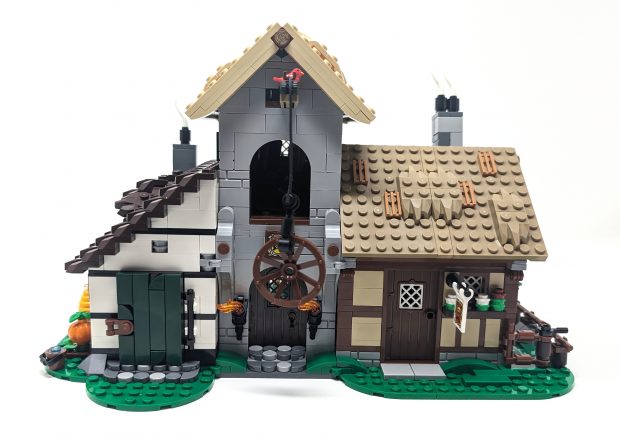
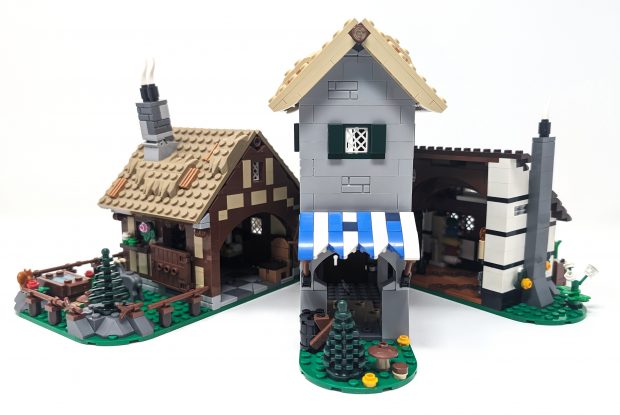

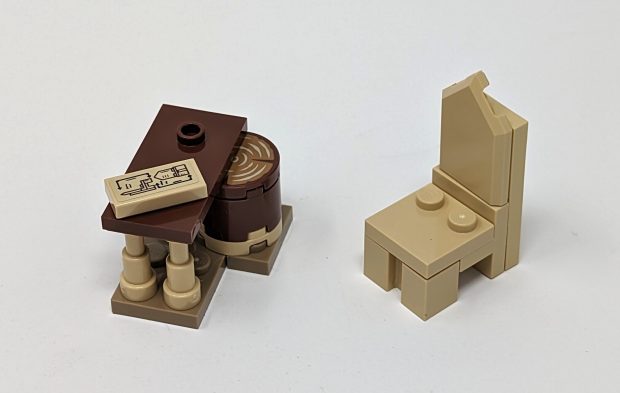
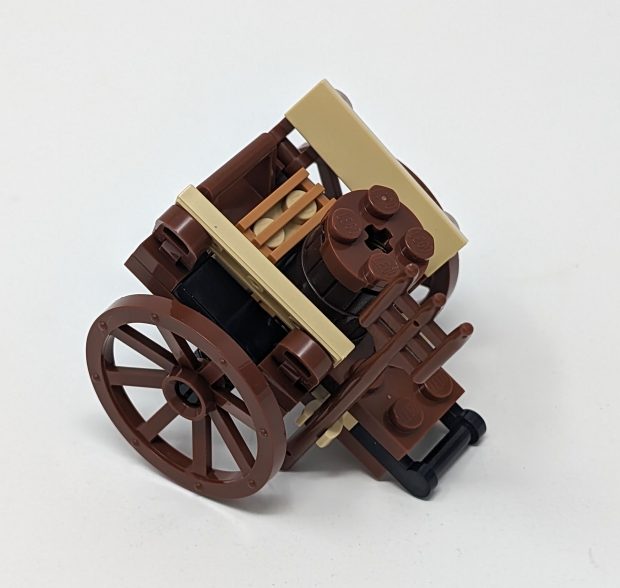

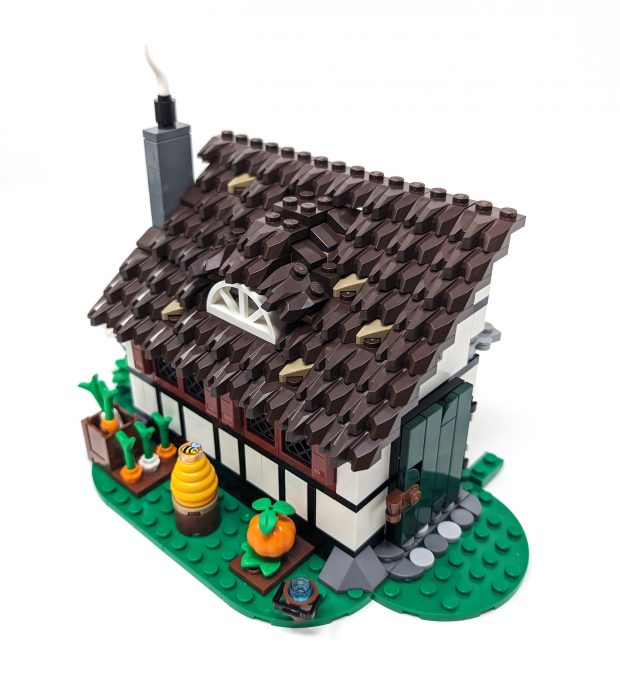
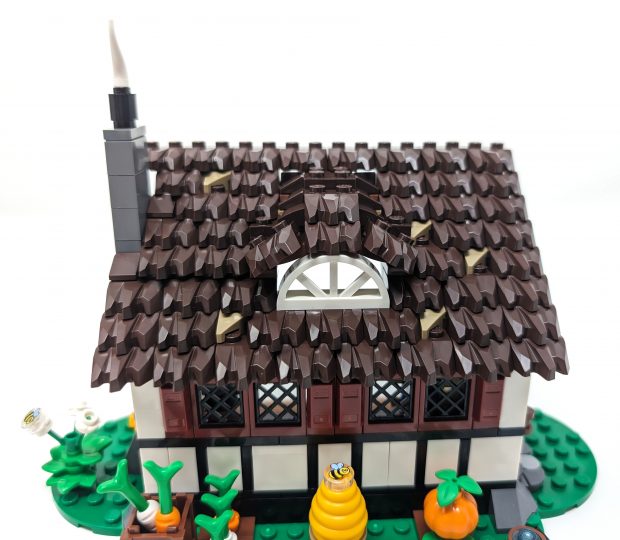
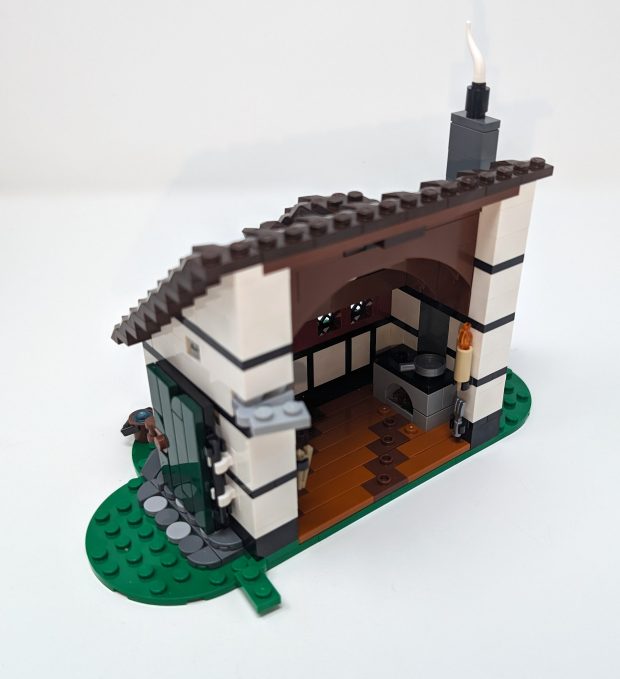

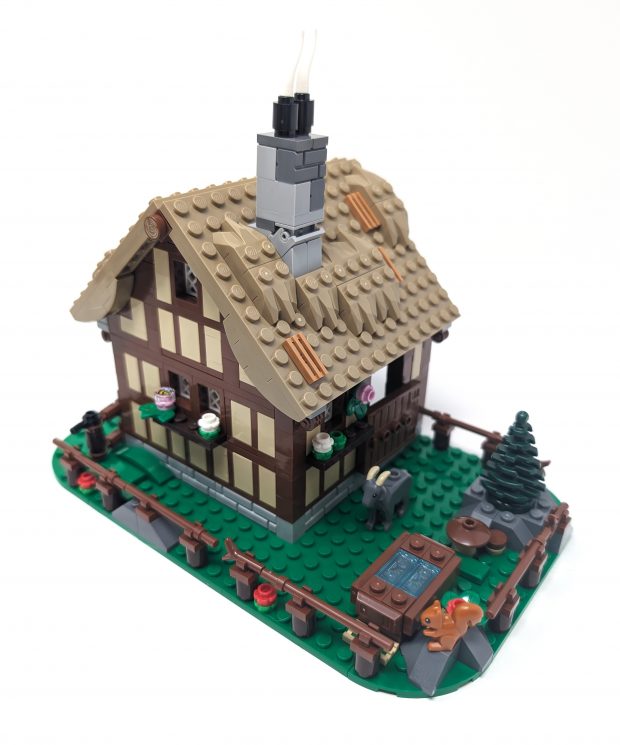
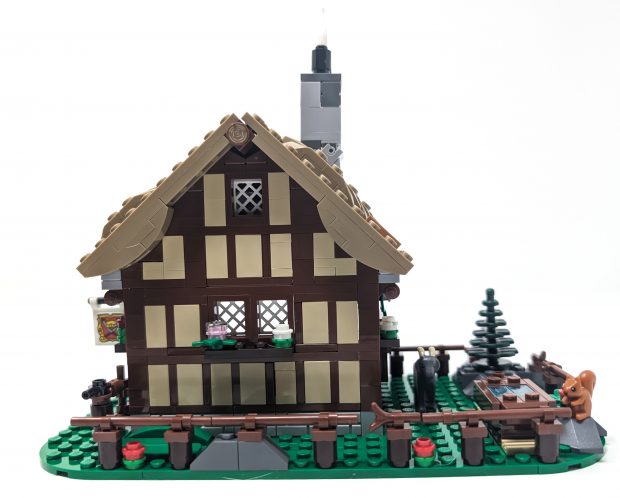


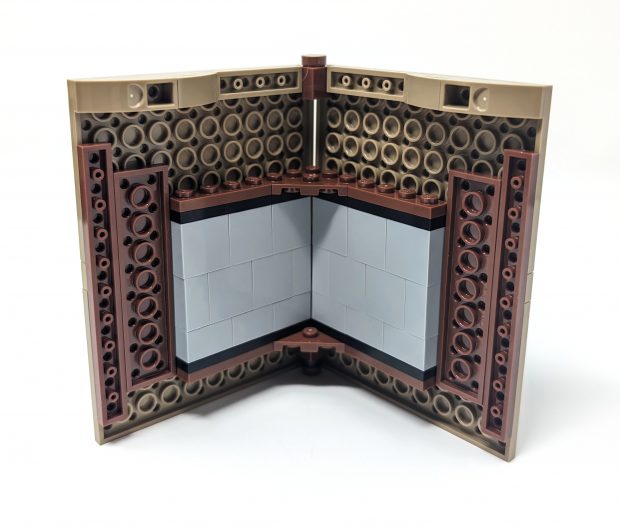
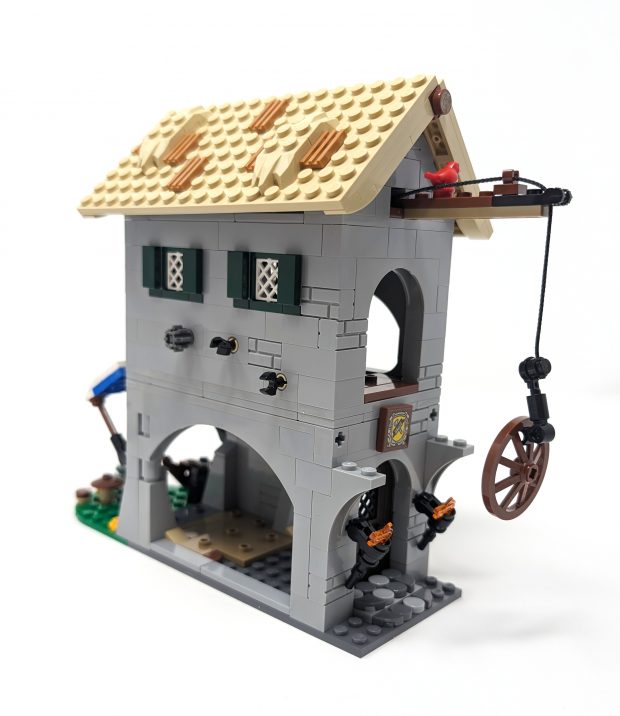
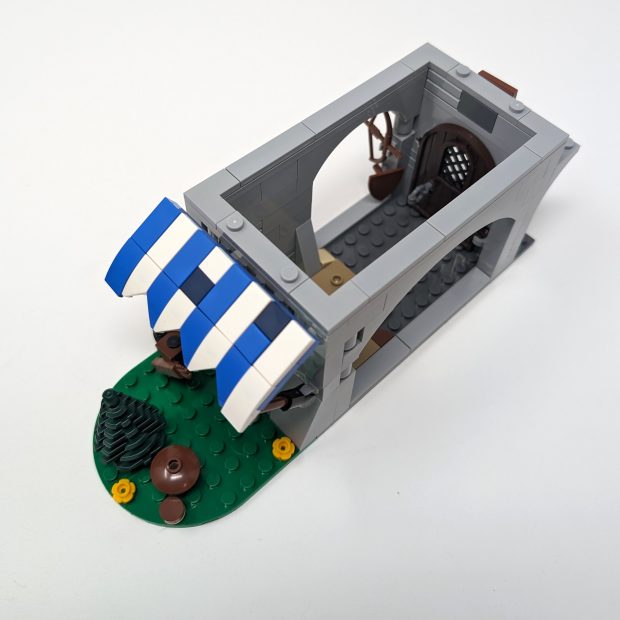
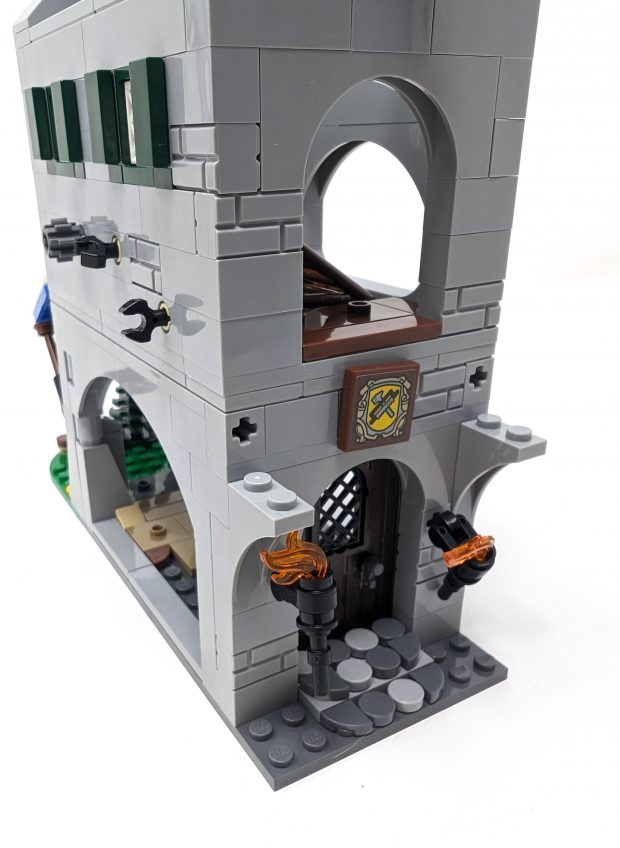

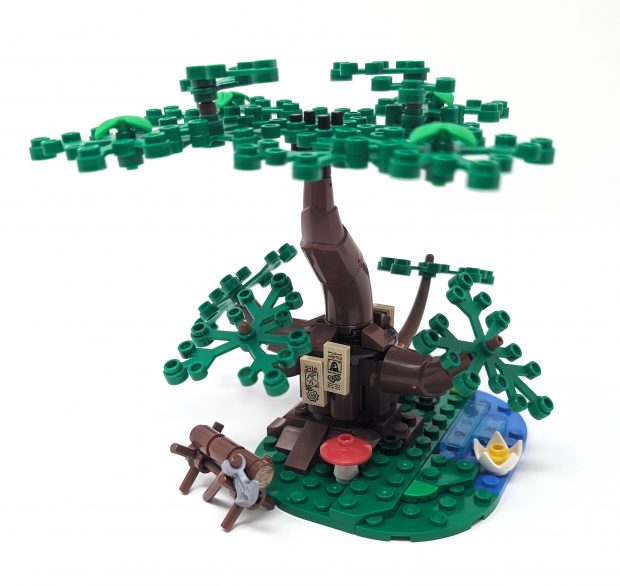
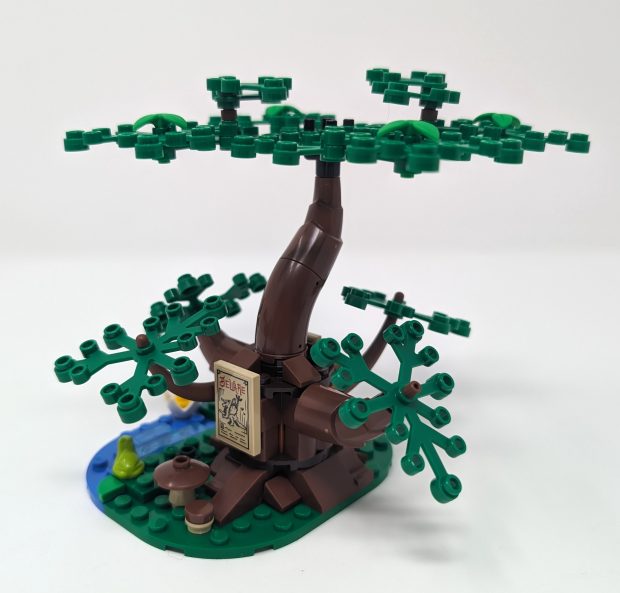

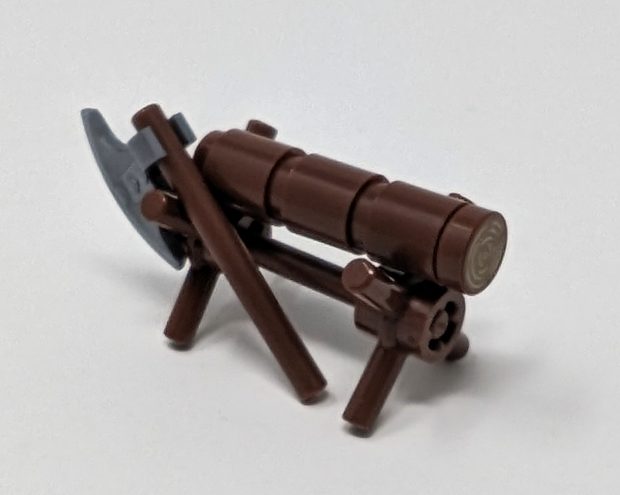
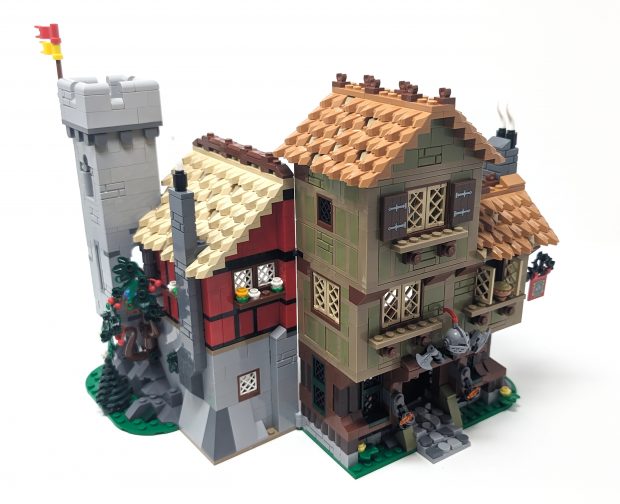

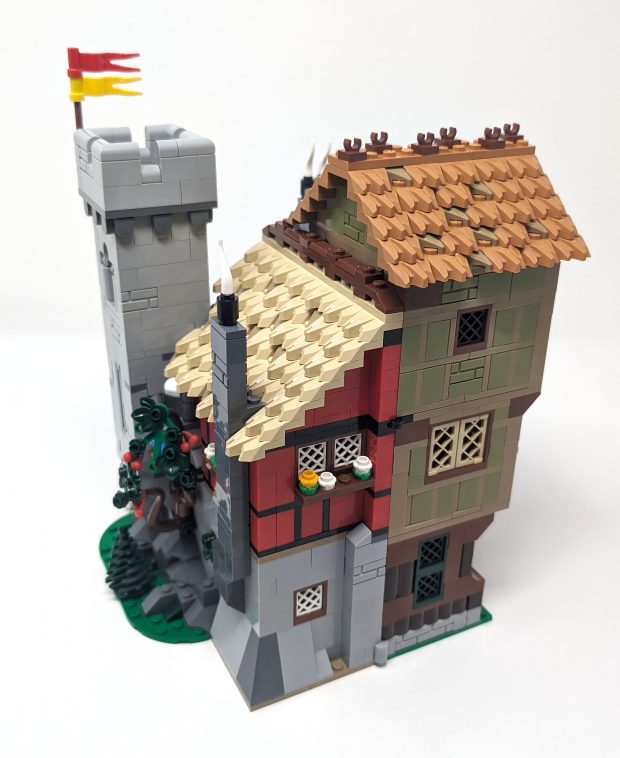
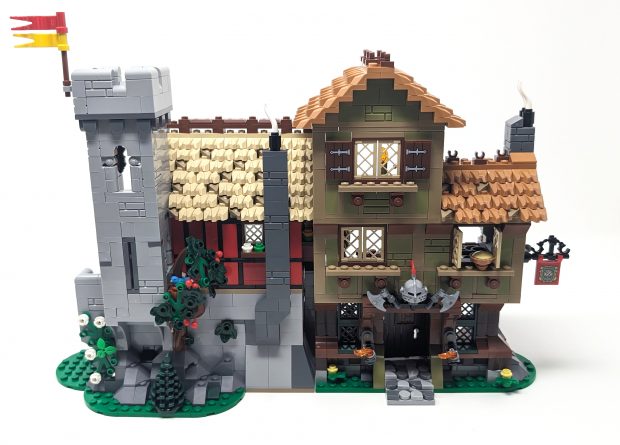
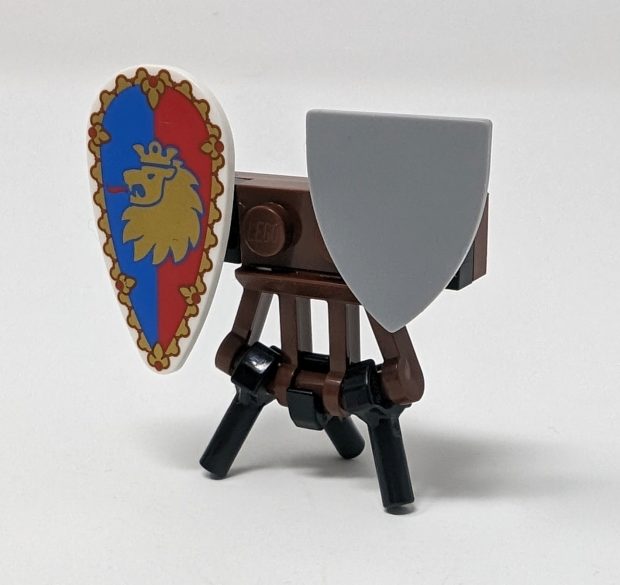
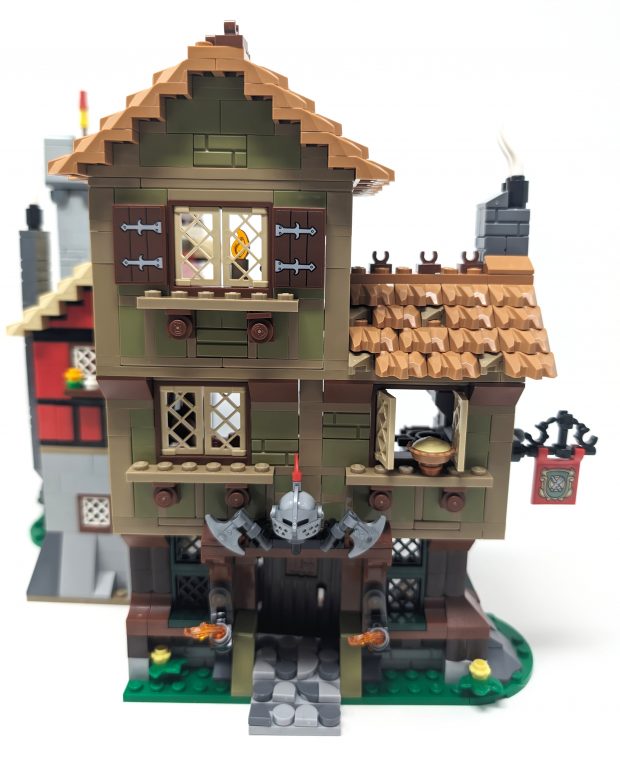
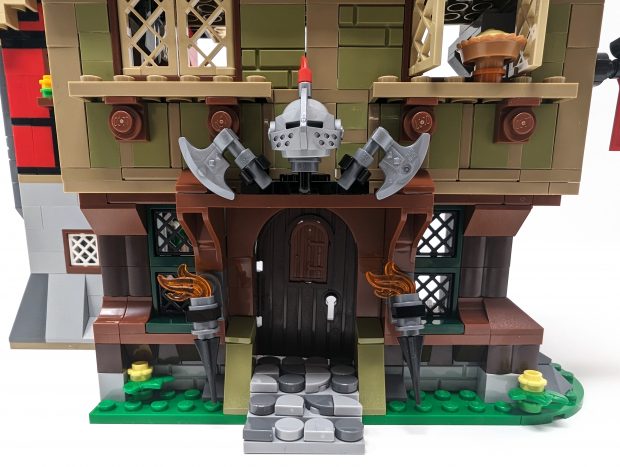
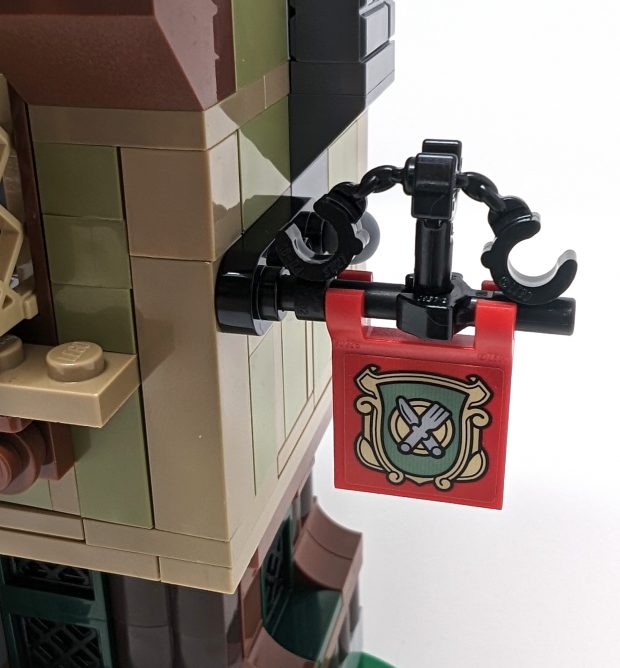
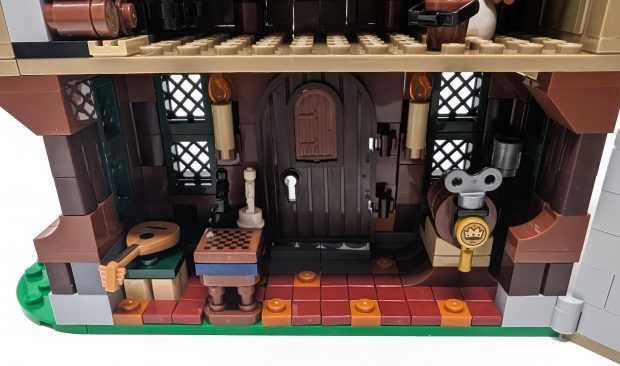
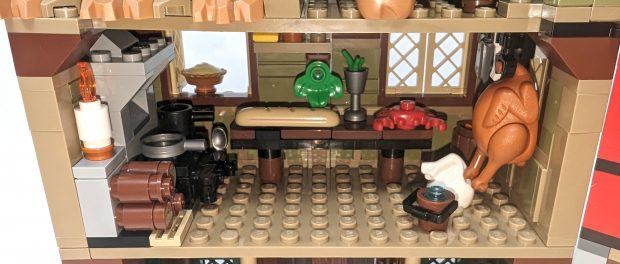


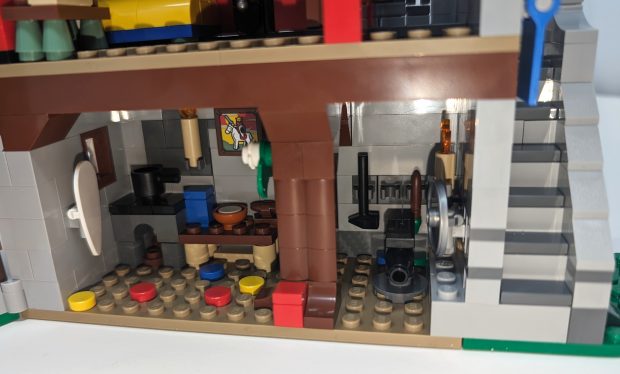

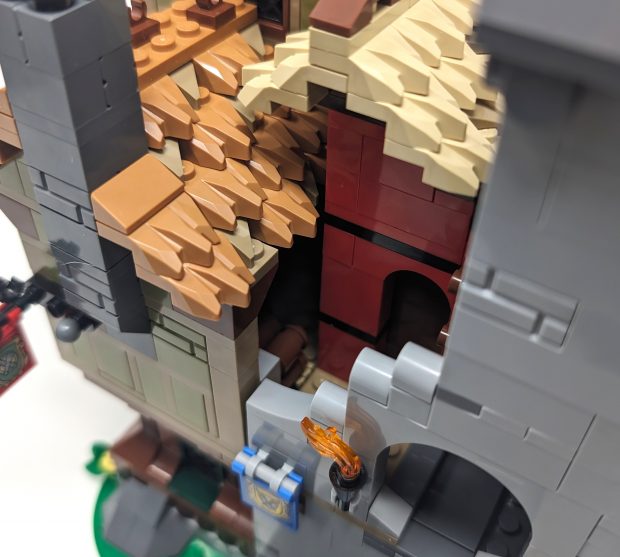

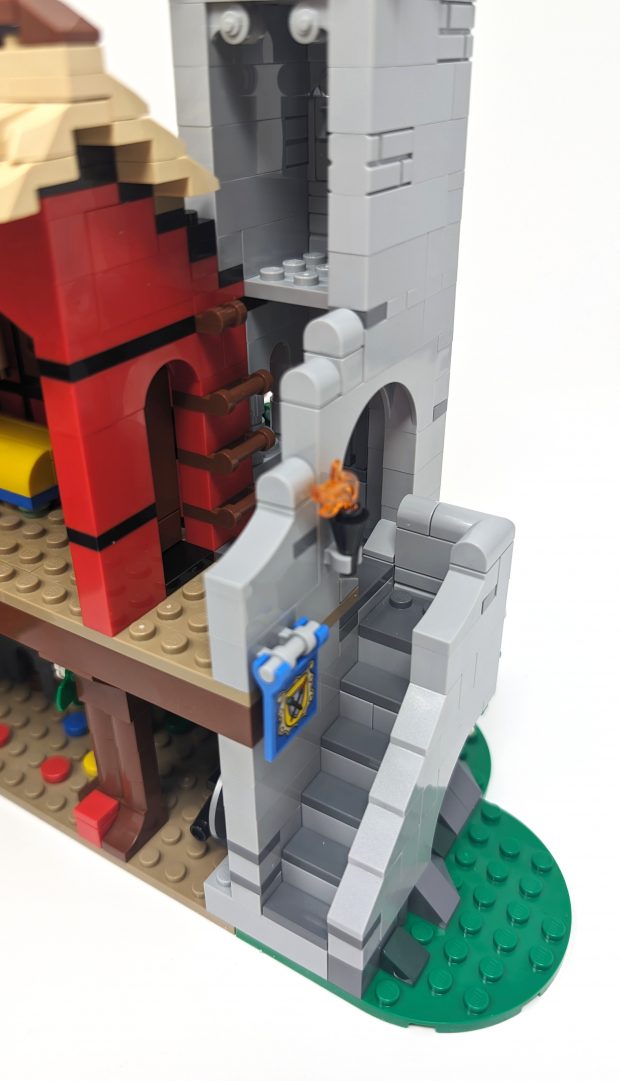
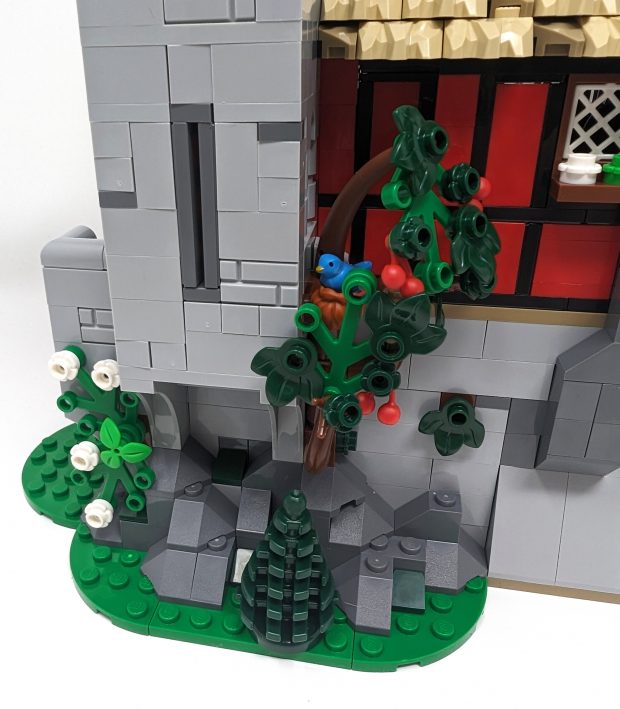
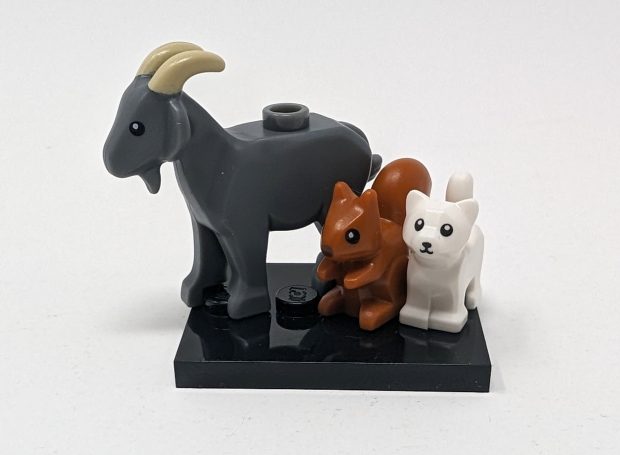

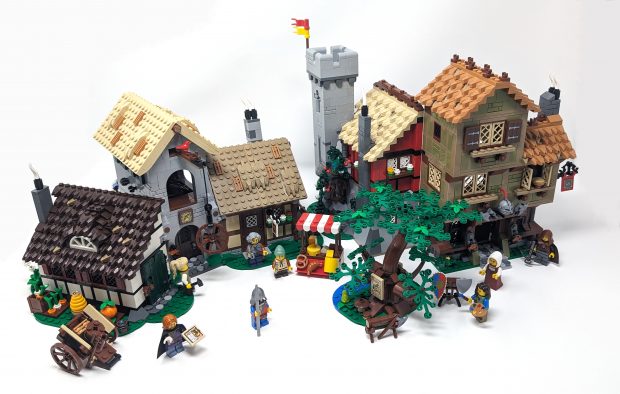
I think it will fall a bit into the what else can I build with this category. This looks like a fun one to build with my kids but at the end of the day it will probably end up heavily modified. Mainly to add another layer of dimension in the stone work and timber framing
I love the “what else can I build” mindset.
The nice thing about this set is that it serves as a great entry point customizability for some people. The shortcomings can sometimes be positives as it can encourage people to make improvements to the build and use some of their own techniques to spruce it up. Just think about how big of an impact small additional details like brick built exposed brick through plates can have on a set like this. When a set is beautifully designed it can sometimes be untouchable, which in this case it is not.
Besides the already mentioned points, if I compare the market to the viking village or the smithy, it falls short. Theses newer sets have much better looking buildings and landscape that I would not put next to the market.
It probably looks good next to the castle, but this is pure nostalgia and no progress in them. So not for me.
I agree, when you put it next to the blacksmith you can see the biggest differences. I wonder if this is due to the high standards that the other sets have put though.
Great and extensive review, thanks for that!
I think the conclusion is surprising, but deserved and well substantiated.
I do have one point of criticism: there are a lot of spelling errors, maybe these can be fixed? They are very distracting from the content.
For example:
– reconizable
– you to display them however you see fitg
– howevever
– We build the wals using
– creative from a strucutral point of view
– based on apperance and utility
– What may seem like a simple detai i seen on the floor
– repetiton
– sloipes
and more, unfortunately.
I am sorry to bring this to your attention, I just think fixing this will improve the quality of your review.
Thanks for the great review, keep up the good work!
Kind regards,
Arjan
Thanks Arjan for catching this. I did multiple edit passes through this but sometimes these little errors slip through grrr! Cons of having long dense articles is that sometimes these get missed. These have been fixed now! I appreciate you catching them 🙂
I think the small build you identified as a spinning wheel is actually a lathe — which can be used together with the carving knife on the tool rack to shape a log from the log rack into the final leg for the table in the carpenter’s workshop!
I feel like the pasture behind the farmhouse/cheese factory would be too small for an animal as large as a cow to comfortably graze, but I do kind of wish that a sheep were included, since it would provide a nice narrative connection between the farm and the weaver’s workshop by providing a nearby source of wool!
Truth be told, the oven in the inn strikes me as sort of an anachronism to me — to me, its Black color suggests cast iron, but cast iron stoves were a much later post-medieval invention. That said, I understand that a more typical medieval hearth might be too space-intensive to fit comfortably in a 2×4 or 3×4 space, so I can accept that practicality likely took priority over realism in this case.
Are there really Warm Tan bricks and plates in this set? To me they look like Sand Yellow (for the farmhouse’s roof and inn’s timbers) and Brick Yellow (for the farmhouse walls). That said, I WOULD love if Warm Tan basic building elements became more readily available beyond the few we’ve gotten from the BrickHeadz theme. It would be a much better match for certain types of treated wood, (including the sort used as flooring in my real-life apartment) than Brick Yellow or any shade of Nougat.
Also, the axes over the inn door and the mug inside the inn are Metallic Silver, not Metalized Silver. Metalized Silver is BrickLink’s “Chrome Silver”, while Metallic Silver is the current color that BrickLink calls “Flat Silver”.
Good review aside from those small errors, though! I definitely appreciate the amount of detail you go into in your reviews.
I was torn between whether it was a lathe or a spinning wheel due to both woodwork and weaving being prominent in this set. With it being situated in the carpenter’s workshop I am inclined to agree with you so will go back to my alternative guess. I have updated the review with what you have pointed out 🙂
While I agree with the space limitation not being big enough for a large animal to graze, I decided to use my imagination as a lot of the details in LEGO sets can be unrealistic by nature. Even if not a cow, the inclusion of a sheep would have been great, especially given that there are scissors included as an accessory, something that could also be shears.
Practicality and build do sometimes take priority over realism. I do wish we saw a hearth as it would be more time perior accurate, but understand the design decision that was taken to build the small oven that we saw.
I just went through the colors again and I think you are correct, it is unfortunately sand yellow not warm tan. LEGO has so many shades of colors and when compared to my color tooling I was using for naming they were close. I have since corrected this to not add confusion. I do wish they had included warm tan though as that adds even more variety! Regardinging silver you are correct thank you 🙂 At least I didn’t accidentally call it the Cool Silver, Drum Lacquered! Although I wish it was that color